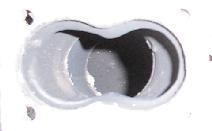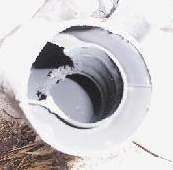Greg Black
gjb at gbch dot net
Home page
Blog front page
If you’re not living life on the edge, you’re taking up too much space.

Syndication
Worthy organisations
Amnesty International Australia — global defenders of human rights
Médecins Sans Frontières — help us save lives around the world
Electronic Frontiers Australia — protecting and promoting on-line civil liberties in Australia
Blogs
(Coming soon…)
Categories
(Coming soon…)
Archives
(Coming soon…)
Software resources
Tue, 01 Mar 2005
How not to do it
When constructing automotive exhaust systems, there are several principles that are considered basic. This is a story of a system where pretty much all those principles were ignored.
After the umpteenth breakage in the very expensive system built for me by Midas Tingalpa, I was so fed up that—rather than deliver the car back there yet again for a lengthy stay and an uncertain repair—I had a completely new set of extractors built elsewhere. I’m not going to say where until I see how the new system goes, although I can say that it’s beautiful and that it feels better on the road.
Today, I took some photos of the old headers, while I was taking the opportunity of inspecting them from the inside for the first time. I knew they weren’t perfect, but I was amazed at just how bad they were. The first picture below is an overview of the number two and three primary pipes, showing the daggy welds, the over-stretched secondary pipe (which has, inevitably, broken where it was stretched), and the nice large primaries welded on to some recycled BMW flanges.
 |
In the next two photos, things are washed out because I was trying to get the extremely black interior of the pipes and my camera’s flash control is not brilliant. However, in the next photo, it’s possible to see inside the top of one of the pipes through the flange and it becomes clear that, although the initial section from BMW is correctly sized, the passage then narrows down to about half size before spilling into the large primaries—which are completely wasted because of the restriction.
 |
The final photo shows inside the bottom of the primaries at the join, looking in from the most recent breakage (with the broken-off piece also visible). This is not so much a case of a restriction as of disgusting workmanship, with great big pieces of pipe protruding into the system and creating bad flow, hot spots, and other problems.
 |
I didn’t make a particular effort to photograph the welds, but every one of them is fat and ugly and that’s just the way to introduce extra weaknesses into the system, as if the excessive stretching of pipes at joins was not enough. It’s no surprise that these pipes lasted such a short time. It was extremely disappointing to discover that, despite having been charged a ridiculously high amount to have them made, they were so poorly done. Obviously, I won’t take any more business to Midas Tingalpa.
| Posted at: 15:57 | Path: /cars | permalink |




